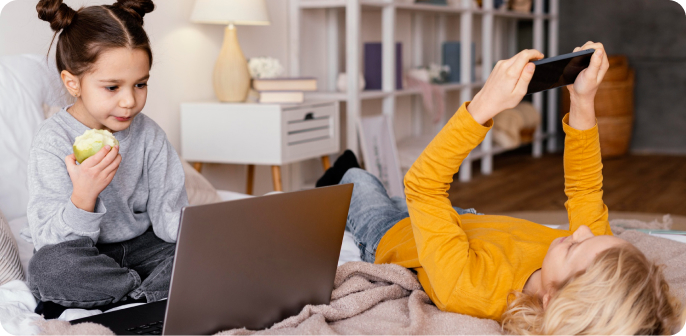Screen time limits have been debated long before smartphones, and it’s only gotten trickier!
Most experts recommend no screen time for kids under 2, and up to 1 hour daily for ages 2–5. Beyond that, the American Academy of Pediatrics and others suggest a personalized approach, as what works for one child may not fit another.
In practice, this means:
- Meeting your child’s essential needs first, and screen time comes last
- Considering your child’s maturity and how they handle screen time
- Looking at what content they’re engaging with and whether they’re active or passive users
Below, we’ll dig deeper into each of those points and unpack what they mean. But before we get to the nitty gritty, it’s worth knowing that Kidslox’s default daily limit is set to 3 hours per day.If you’re unsure where to start, use this limit and observe your child’s behaviour. Adjust up or down based on what you see.
Now, let’s think more deeply about the different factors that go into setting a screen time limit.
Prioritize essential needs first
This might seem self-evident, but it’s amazing how, without firm rules in place, children often start replacing essential other activities with screen time.
Here are basic priorities to cover before allowing screen time:
- a good night’s sleep (8+ hours)
- school attendance + homework completion
- regular, healthy meals (preferably eaten together with other family members)
- time socialising with peers
- time socialising with family
- physical activity (over an hour per day)
With all of these in place, you’re off to a good start.
Consider your child’s maturity
You likely know your child’s habits well, but it helps to check the data. Kidslox gives you insights into their usage patterns and the content they consume.
Signs your child may need limits:
- Mood or behaviour worsens after screen time
- Struggles to stop when asked
- Chooses screens over sleep, exercise, or other priorities

Look at the content and engagement
Quality matters as much as quantity. Not all screen time is equal.
Passive screen time (e.g., endless scrolling) tends to be less helpful, while active use (e.g., creating something, learning, or socializing) can be more positive.
Watch how your child interacts, not just what they watch or play:
- Are they solving problems, creating, or learning?
- Or are they zoning out without much thought?
Games and social media can be used actively or passively, depending on the child.
A complex challenge
These factors are connected. Maturity affects content choices; screen time may affect sleep or social habits. Your child’s needs will change over time.
Finding the right balance is an ongoing process. Start with a thoughtful limit, observe how it affects your child’s wellbeing, and adjust as needed.
Kidslox is here to support you along the way.
